![]()
![]()
![]()
Use LEFT and RIGHT arrow keys to navigate between flashcards;
Use UP and DOWN arrow keys to flip the card;
H to show hint;
A reads text to speech;
37 Cards in this Set
- Front
- Back
|
What % of nematodes are parasites of animals?
|
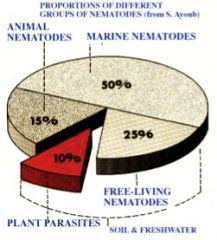
15%
|
|
|
How diverse and fecund are nematodes?
|
Very.
They can lay up to 200K eggs/day and are the 2nd most diverse group of animals, behind only the insects |
|
|
What group of helminth is the the most important group in domesticated animals?
|
Nematode.
|
|
|
Do nematodes have separate sexes? What is that called? What are their physical characteristics?
|
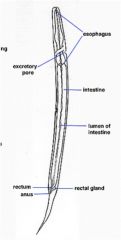
long thin tube, a hydrostatic skeleton
morphological elaboration concentrated around openings straight gut with highly variable pharynx sexes are _separate_(dioecious) |
|
|
What are the external anterior modifications of nematodes?
|

Cuticular modifications at the anterior ends of many nematodes may include teeth, leaf crowns, vesicles, alae and papillae.
|
|
|
What is a leaf crown?
|
Leaf crowns: Rows of finger-like projections surrounding the rim of the opening to the buccal cavity. Strongyles of horses.
|
|
|
What are vesicles as external modifications of nematodes?
|
Vesicles: inflations of the cuticle around the mouth (cephalic) and the anterior esophagus (cervical).
|
|
|
What are alae as external modifications of nematodes?
|
Alae: "wing-like" expansions of the cuticle.
|
|
|
What are the posterior external modifications of nematodes?
|
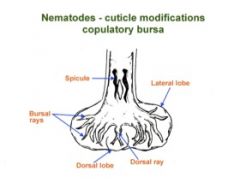
Males Order Strongylida – the ‘bursate’ nematodes) caudal alae expanded to form copulatory bursa –
male to grasp the female during copulation. During copulation it is greatly expanded and used to grasp the female. |
|
|
What is the internal morphology of a nematode? How many layers of body wall do they have?
|
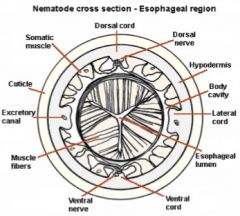
body is essentially an outer tube enclosing an inner tube (the digestive tract) supported by hydrostatic pressure.
The body wall has three layers:__cuticle_, hypodermis and an inner layer of muscle cells. |
|
|
what is the major variation between nematodes?
|
Their mouth openings.
Variations in sizes of the mouth opening, buccal capsule and esophagus. Simple opening = a tiny buccal cavity leading directly to the esophagus e.g. Nematodirus Large mouth opening, prominent buccal cavity, thick walls & teeth (e.g. Stongylus vulgaris). |
|
|
What determines the type of buccal cavity that nemaotdoes have?
|
Type related to diet.
large: bite of mucosa, and drawing it into the buccal cavity where it is digested (e.g. the large strongyles of horses). Called ‘_plug feeders_’. Simple opening = a tiny buccal cavity leading directly to the esophagus e.g. Nematodirus Large mouth opening, prominent buccal cavity, thick walls & teeth (e.g. Stongylus vulgaris). Small mouth opening: host fluids (e.g. Ostertagia) Intermediate: “grazers” (e.g. Oesophagostomum radiatum large intestine of swine). |
|
|
What are large mouth opening nematodes called? What's a big group that has these?
|
large: bite of mucosa, and drawing it into the buccal cavity where it is digested (e.g. the large strongyles of horses). Called ‘_plug feeders_’.
Also in hookworms. |
|
|
What are intermediate sized buccal cavity nematodes called?
What do the small mouth opening nematodes feed on? |
Intermediate: “grazers”
(e.g. Oesophagostomum radiatum large intestine of swine). Small mouth opening: host fluids (e.g. Ostertagia) |
|
|
What is the signifigance of the esophagus in nematodes?
|
Esophagus: shape often used as an initial screening characteristic for identification.
Superfamily Strongyloidea: club-shaped (strongyliform) esophagus. Superfamily Oxyuroidea (pin worms): prominent posterior bulb (separated from the rest of the esophagus by a narrow isthmus). |
|
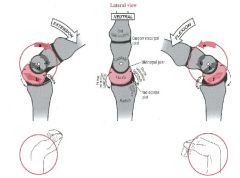
Describe the female reproductive tract of nematodes.
|
The female reproductive system tubular two ovaries, each of which connects to an oviduct, and a uterus.
|
|
|
Is the nematode development direct or indirect? Do they use paratenic hosts?
|
Life cycle can be direct or indirect (invertebrate intermediate hosts in some, lots with paratenic hosts)
|
|
|
What happens to the nematode cuticle in development molting?
How many molts do nematodes undergo? |
During development molting occurs and old cuticle is shed (occasionally retained as a ‘sheath’)
Usually 4 molts (ecdyses) |
|
|
What are the stages of nematode development?
NEED TO KNOW |
Stages: egg → L1→ L2→ L3 → L4 → L5/adult
"L" means larval Also called “J1 through J5” "J" means juvenile - more appropriate, but the other is more widely used. NEED TO KNOW |
|
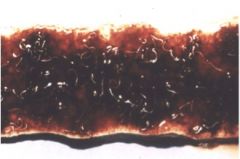
ID
What's the number one clinical sign we see with nematodes? |

Canine ancylostomosis – hemorrhagic enteritis, small intestine
Anemia |
|
|
Where are we likely to find nematodes in the host?
What is the most damaging life cycle of nematodes? |
We'll likely find them in the intestines.
The adults can be damaging, but often, like strongyles, the migrating juveniles are the most damaging. |
|
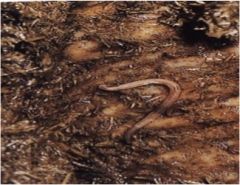
ID
|

Strongylus sp. attached to mucosa of horse large intestine
|
|
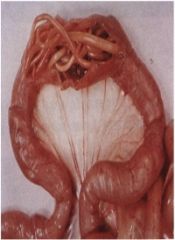
ID
|

Ascaris of pigs – small intestine
|
|
|
What is a roundworm?
|
Any nematode.
Typically referring to toxocara canis. Ascarid is also referring to something general too....look into this, or ask someone! |
|
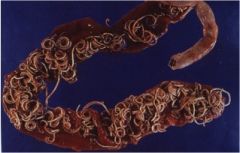
ID
|

Toxocara canis – fatal infection in puppy
|
|

ID
|
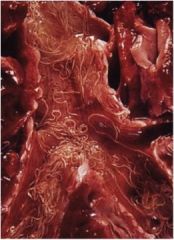
Lungworm in the bronchii and trachaea of cattle
One of the nematodes that is more dangerous in the adult form. |
|
|
what are the clinical signs of nematode infection?
|
impaired weight gain
impaired food conversion reduced fitness, eg heartworm |
|
|
What is the particular danger of toxocara to humans?
|
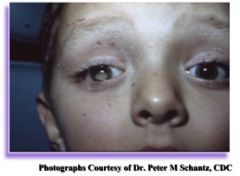
Visceral & _Ocular Larval Migrans
Toxocara spp. |
|
|
What are the six orders of veterinary importance in the nematode class?
|
Rhabditida -
Strongylida - strongyles Ascaridida Oxyurida - pinworms Spirurida Enoplodida |
|
|
What is the superfamily of Oxyurida order of parasites?
What kinds of animals are they found in? |
Order: Oxyurida (pinworms)
SuperFam: Oxyuroidea Simple life cycle Mostly in large intestine Humans, horses, _lab rodents_ |
|
|
What is the superfamily of Rhabditida of Nematodes?
|
Order: Rhabditida
SuperFam: Rhabditoidea |
|
|
What are the superfamilies of the order Strongylida of Nematodes?
|
Order: Strongylida
SuperFam:Trichostrongyloidea [hair worms (some lung)] SuperFam: Strongyloidea [‘true strongyles’] SuperFam: Metastrongyloidea [lung worms] |
|
|
What is a strongyloides vs a strongyles?
What is a hookworm in this bucket of nonsense? |
Genus Strongyloides (order Rhabditida)
The true strongyles (order Strongylida) Many families and genera, lots in large animals. Hookworms (also order Strongylida) but not referred to as usually not referred to as strongyles |
|
|
What is the superfam of the order Ascaridida of Nematodes?
|
Order: Ascaridida (big roundworms Ascarids)
SuperFam: Ascaridoidea [ascaridoids/ascarids] |
|
|
What are the superfamilies of the order Spirurida of Nematodes?
|
SuperFam: Spiruroidea
[spirurids] SuperFam: Filarioidea [filarial worms] |
|
|
What is the superfamily of the order Enoplodida of Nematodes?
|
SuperFam: Trichuroidea
[enoplids] |
|
|
In summary, what are the important concepts to keep in mind in sorting through these worms?
|
Very general idea of nematode anatomy
Some idea of distinguishing features How functional morphology relates to biology e.g. feeding, reproduction, movement Life Cycles: Variability in the post-embryonal development exists and it relates to diagnosis (i.e. unembryonated, embryonating, embryonated, L1 stages released – fecal exam) Variables in response to abiotic stimuli impact on epidemiology and effectiveness of treatments (hypobiosis) |

